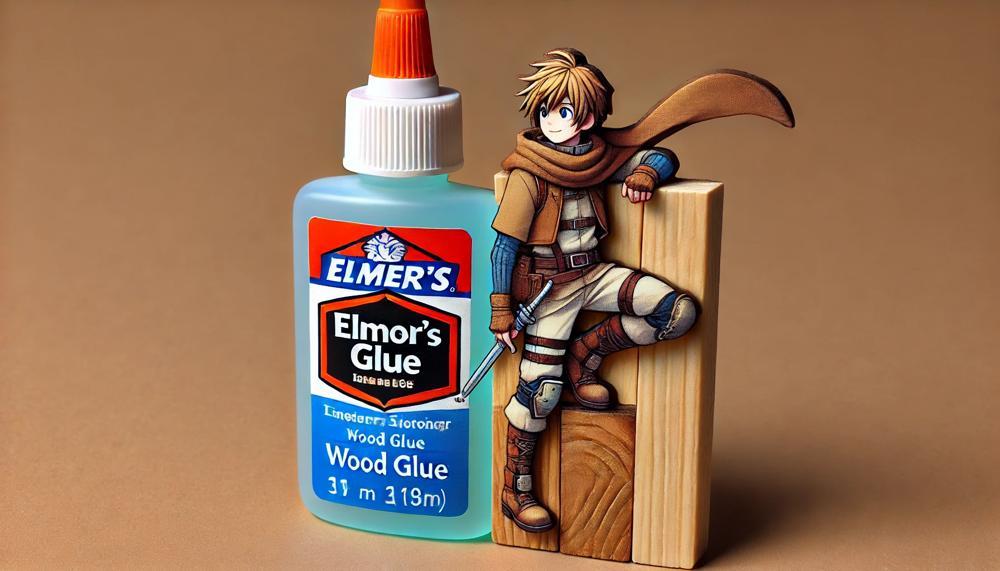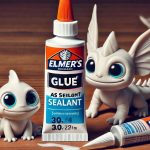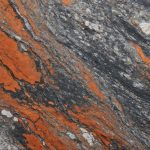When you’re diving into a woodworking project, choosing the right adhesive is crucial. So, can Elmer’s glue be used as wood glue? The short answer is “Yes,” but with some important caveats. While Elmer’s glue, particularly their white school glue, is a versatile and budget-friendly adhesive that works well for lightweight projects and porous materials, it’s not designed to provide the robust, durable bond that wood glue offers for serious woodworking tasks.
Wood glue, such as Elmer’s Carpenter’s Wood Glue, is specifically formulated for wood surfaces, delivering a stronger, more resilient bond that’s essential for furniture, cabinetry, and other high-stress applications. Elmer’s glue can serve as a temporary fix or for small, light-duty woodworking projects, but for anything that requires lasting strength, wood glue is the go-to choice.
Key Takeaways:
- Versatility: Elmer’s glue is great for lightweight, porous materials.
- Strength: Wood glue provides a stronger, more durable bond.
- Cost: Elmer’s glue is generally more affordable.
- Application: Use wood glue for heavy-duty projects; Elmer’s glue can work for temporary or light-duty fixes.
- Compatibility: Elmer’s glue and wood glue can be used together in some cases, but they have distinct purposes.
Understanding these differences can help you select the right adhesive for your project, ensuring that your woodworking creations stand the test of time.
Table of Contents
- 1 What Types of Wood Can Be Used with Elmers Glue?
- 2 Advantages and Disadvantages of Using Elmers Glue as a Wood Glue
- 3 Alternatives to Using Elmers Glue on Wood
- 4 Safety Precautions when Working with Any Type of Glue
- 5 How to Choose the Right Woodworking PVA Glue
- 6 Tips for Using Elmers Glue on Wood Projects
- 6.1 Type of Wood
- 6.2 Moisture Content
- 6.3 Project Size and Complexity Elmer’s glue is suitable for small to medium-sized projects. For larger, more complex projects that require a stronger bond, consider using a more robust adhesive like epoxy. Glue Type Different types of PVA glues have varying strengths, drying times, and water resistance. Choosing the right type of Elmer’s glue is essential based on the specific requirements of your project. Application Technique
- 6.4 Drying Time
- 6.5 Clean-Up
- 6.6 Temperature and Environment
- 7 Alternatives to Using Elmers Glue on Wood
- 8 Safety Precautions when Working with Any Type of Glue
- 9 How to Choose the Right Woodworking PVA Glue
- 10 Tips for Using Elmers Glue on Wood Projects
- 10.1 Select the Appropriate Glue
- 10.2 Understand Wood Types
- 10.3 Surface Preparation
- 10.4 Application Technique
- 10.5 Clamping
- 10.6 Avoiding Common Mistakes Don’t rush the drying process; insufficient drying time can weaken the bond. Use the right amount of glue. Too much can create a messy bond, while too little won’t hold. Safety and Cleanliness
- 11 Conclusion
What Types of Wood Can Be Used with Elmers Glue?
When selecting wood to use with Elmers Glue, it’s crucial to understand which types bond most effectively with this adhesive. The ideal types of wood are those that are softer and have a more porous structure, allowing for better penetration and adhesion of the glue.
-
Softer Woods
- Pine: This wood is commonly used because of its soft, porous nature, which allows Elmers Glue to penetrate deeply, ensuring a strong bond.
- Cedar: Known for its aromatic properties, cedar’s porous texture makes it another excellent choice for Elmers Glue.
- Poplar: This wood, though slightly harder than pine or cedar, still provides a good surface for Elmers Glue to adhere to effectively.
-
Consider Moisture Content
- Moderate Moisture Content: Woods with moderate moisture levels work best. High moisture content can dilute the glue, while too low moisture can prevent proper adhesion.
-
Grain Direction
- Parallel Grain: For optimal bonding, align the grain direction of the wood pieces parallel to each other. This alignment maximizes the contact surface area, enhancing the glue’s effectiveness.
Here’s a table summarizing the best types of wood for use with Elmers Glue:
| Wood Type | Characteristics | Why It Works Best |
| Pine | Soft, porous | Allows deep penetration of glue |
| Cedar | Soft, aromatic | Porous texture for strong bond |
| Poplar | Slightly harder, yet porous | Provides effective surface for adhesion |
For further reading, you can explore more about the properties of different woods on Wikipedia’s Wood Page.
Advantages and Disadvantages of Using Elmers Glue as a Wood Glue
| Advantages | Disadvantages |
| Cost-Effective: Elmers glue is widely available and inexpensive, making it a budget-friendly option for many woodworking projects. | Weaker Bond: Elmers glue generally provides a weaker bond compared to specialized wood glues, which can compromise the structural integrity of heavier or more demanding projects. |
| Easy to Use: Its straightforward application and clean-up process make it user-friendly, especially for beginners and DIY enthusiasts. | Not Waterproof: Unlike many wood glues, Elmers glue is not waterproof, which can lead to bond failure in high-moisture environments or outdoor use. |
| Versatile: Suitable for a variety of materials and projects, including paper, fabric, and some types of wood like pine and cedar. | Limited Heat Resistance: Elmers glue is not heat-resistant, which can be a significant drawback for projects exposed to varying temperatures. |
| Non-Toxic: Safe for use in projects where non-toxicity is a priority, such as children’s crafts. | Not Suitable for All Woods: Certain hardwoods, such as teak and mahogany, do not bond well with Elmers glue. |
| Accessibility: Easily found in most stores and online, ensuring that it’s readily available for immediate purchase. | Not Ideal for Heavy-Duty Projects: For large-scale or load-bearing woodworking tasks, Elmers glue may not offer the required strength. |
Elmers glue is a convenient and cost-effective option for many woodworking projects, particularly those involving softer woods and non-structural components. However, its weaker bond, lack of waterproofing, and limited heat resistance make it less suitable for heavy-duty or outdoor applications. For projects requiring more durability and resistance, alternatives like epoxy or specialized wood glues are recommended.
Alternatives to Using Elmers Glue on Wood
When tackling wood projects, several alternatives to Elmers Glue can provide stronger, more durable bonds, especially for heavy-duty or outdoor applications. Here’s a closer look at some of the top contenders:
| Type of Glue | Description | Best Used For |
| Gorilla Wood Glue | This PVA glue is known for its strong initial tack and water resistance. It’s easy to apply, dries to a natural color, and is sandable. | Indoor and outdoor wood projects, including furniture and cabinetry. |
| Titebond III | A superior wood glue with a waterproof formula. It provides excellent bond strength and longer open assembly time. | Outdoor projects, woodworking with exposure to moisture, and complex assemblies. |
| Epoxy Resin | Epoxy consists of two parts: a resin and a hardener. When mixed, they form a very strong and durable bond that is resistant to moisture and heat. | Structural repairs, gap filling, and bonding dissimilar materials like metal and wood. |
| Weldbond Universal Adhesive | This versatile adhesive bonds a variety of surfaces including wood, tiles, glass, and more. It’s non-toxic and dries clear. | General repairs, arts and crafts, and mixed material projects. |
| Polyurethane Glue | Polyurethane glue expands as it cures, providing a strong bond that is waterproof and highly resistant to temperature changes. | Outdoor furniture, decking, and heavy-duty wood joints. |
These alternatives each offer unique benefits that can significantly enhance the durability and strength of your woodworking projects.
Safety Precautions when Working with Any Type of Glue

Ensuring your safety when using Elmer’s glue as a wood glue substitute involves several key precautions:
- Ventilation: Always work in a well-ventilated area. Elmer’s glue emits low fumes, but good airflow reduces any potential irritation.
- Skin Protection: Wear gloves to avoid skin contact. Although non-toxic, prolonged exposure can cause minor skin irritation.
- Eye Protection: Use safety goggles to protect your eyes from accidental splashes.
- Workspace Preparation: Cover your workspace with a protective layer like newspaper or a plastic sheet to prevent glue from damaging surfaces.
- Storage: Store Elmer’s glue in a cool, dry place, out of reach of children and pets. Make sure the cap is tightly sealed to prevent spillage.
- Handling: If the glue comes into contact with skin or eyes, rinse immediately with plenty of water. For severe reactions, seek medical advice.
- Proper Application: Apply thin, even layers and avoid excessive use, which can lead to dripping and accidental contact.
How to Choose the Right Woodworking PVA Glue
When selecting a PVA glue for woodworking, several crucial factors must be considered to ensure the adhesive meets the specific needs of your project.
Type of PVA Glue
- Standard PVA Glue: Ideal for indoor projects where moisture resistance is not a priority.
- Water-Resistant PVA Glue (Type I and II): Suitable for outdoor or high-moisture environments. Type I offers higher water resistance than Type II.
Bonding Strength
- Look for a glue with a bonding strength of around 3,500 to 4,000 psi for robust, durable joints. This is essential for projects that will bear weight or endure stress.
Drying Time
- Consider the glue’s drying time, typically around 24 hours. Faster drying glues are available but may require more precision during application.
Flexibility and Longevity
- PVA glue is known for its flexibility, making it a good choice for projects that may experience movement or stress over time.
Material Compatibility
Acid-Free Composition
- For projects requiring archival quality, such as art or historical restorations, choose an acid-free PVA glue to avoid material degradation over time.
Scent
- PVA glues generally lack a strong scent, making them more pleasant to work with in indoor environments.
Tips for Using Elmers Glue on Wood Projects
Using Elmer’s glue on wood projects requires attention to several crucial factors to ensure a strong and lasting bond.
Type of Wood
- Porous woods like pine, cedar, and fir are ideal for Elmer’s glue. These woods allow the glue to penetrate deeply, ensuring a firm bond.
- Non-porous woods such as teak and mahogany may not bond as well with Elmer’s glue due to their dense nature.
Moisture Content
- Wood should neither be too dry nor too moist. Excessive moisture can weaken the glue bond, while overly dry wood can prevent the glue from adhering properly.
Project Size and Complexity
-
Elmer’s glue is suitable for small to medium-sized projects. For larger, more complex projects that require a stronger bond, consider using a more robust adhesive like epoxy.
Glue Type
-
Different types of PVA glues have varying strengths, drying times, and water resistance. Choosing the right type of Elmer’s glue is essential based on the specific requirements of your project.
Application Technique
-
Apply a thin, even layer of glue on both surfaces to be joined. Press the pieces together firmly and clamp them if necessary to ensure a tight bond.
Drying Time
-
Allow sufficient drying time as recommended by the manufacturer. Rushing this process can compromise the strength of the bond.
Clean-Up
-
Elmer’s glue is water-soluble, making clean-up easy with just soap and water before the glue dries.
Temperature and Environment
- Use the glue in a well-ventilated area at room temperature. Extremely cold or hot environments can affect the glue’s performance.
Alternatives to Using Elmers Glue on Wood
Several alternatives to Elmers glue can be used on wood, depending on the project requirements and desired outcomes. Here are some effective options:
Adhesive Type
Description
Best Uses
PVA Glue
Polyvinyl acetate (PVA) is a type of thermoplastic. It dries clear and is easy to clean up with water.
General woodworking, furniture repair, crafts
Epoxy Resin
Epoxy glue creates an incredibly strong bond. It’s resistant to moisture and chemicals, and can be sanded and painted once cured.
High-strength bonding, outdoor projects, structural repairs
Cyanoacrylate Glue
Commonly known as superglue, it provides a quick and strong bond, ideal for small repairs.
Small fixes, intricate or detailed work, model building
Polyurethane Glue
This adhesive expands as it cures, filling gaps effectively. It is waterproof and extremely strong but can be messy.
Outdoor furniture, wood joinery, projects requiring gap-filling
Natural Adhesives
Eco-friendly options include starch, flour, and tree sap-based glues. These are sustainable and non-toxic.
Eco-friendly projects, crafts, quick fixes with sustainable materials
PVA glue is a versatile, easy-to-use option suitable for most wood projects. Epoxy resin provides unmatched strength and durability, ideal for outdoor and heavy-duty applications. Cyanoacrylate glue, or superglue, works well for quick, small repairs.
Polyurethane glue’s expanding nature makes it perfect for gap-filling but requires careful application to avoid mess. Natural adhesives offer an eco-friendly alternative, though they may not always provide the same strength as synthetic options.
Safety Precautions when Working with Any Type of Glue
When using Elmer’s glue or any other type of adhesive, it’s crucial to follow certain safety measures to protect yourself and others. Here are some key precautions to keep in mind:
Precaution
Details
Additional Tips
Avoid Prolonged Skin Contact
Minimise direct contact with the glue. Use gloves or barrier creams, especially if you have sensitive skin.
Wash any glue off your skin immediately to prevent irritation.
Keep Out of Reach of Children and Pets
Store glue in a secure location away from children and animals to prevent accidental ingestion or contact.
Consider childproof locks for storage cabinets.
Ensure Adequate Ventilation
Use glue in a well-ventilated area to avoid inhaling fumes, which can be harmful.
Open windows or use a fan to increase airflow in your workspace.
Read Instructions Carefully
Follow all manufacturer instructions for safe and effective use of the glue.
Refer to the product’s safety data sheet (SDS) for detailed information.
Avoid Ingestion and Inhalation
Do not ingest glue or inhale its fumes as it can cause health issues.
Seek medical attention immediately if ingestion occurs.
Understand Ingredients
Familiarise yourself with the ingredients in the glue to ensure it’s safe for your intended use.
Consider using non-toxic alternatives when possible.
Seek Medical Attention for Reactions
If you experience skin irritation or other adverse reactions, seek medical help promptly.
Keep emergency contact numbers handy.
How to Choose the Right Woodworking PVA Glue
When choosing the right woodworking PVA glue for a project, consider the following key factors:
Factor
Details
Recommended Use
Type of PVA Glue
Type I (high water resistance), Type II (moderate water resistance), Type III (lower water resistance)
Outdoor and indoor projects
Bond Strength
Ensure strong adhesion for wood
Durable and long-lasting bonds
Drying Time
Varies from quick drying to longer working time
Fast assembly or complex assemblies
Viscosity
Thicker for gaps, thinner for tight joints
Vertical surfaces or precise joins
Application Method
Brushing, squeezing, rolling
Varies with project needs
Water Resistance
High for outdoor, standard for indoor
Exposure to moisture
Colour
Clear, yellow, or white drying
Aesthetic requirements
Shelf Life
Check for degradation over time
Maintains performance
Tips for Using Elmers Glue on Wood Projects
Select the Appropriate Glue
- Use Elmer’s Carpenter’s Wood Glue, designed specifically for wood projects, ensuring a robust bond.
Understand Wood Types
- Different woods have varying porosity. Softwoods may need more glue, while hardwoods might require a stronger adhesive.
Surface Preparation
- Clean and sand the wood surfaces to remove dust and debris. This ensures better adhesion.
- Apply a wood conditioner if necessary to promote even absorption.
Application Technique
- Spread the glue evenly and thinly on both surfaces to avoid excessive glue squeeze-out.
- Consider using a brush or roller for a uniform layer.
Clamping
- Use clamps to hold the pieces together firmly while the glue dries. This ensures a strong bond.
- Allow ample drying time, usually 24 hours, to achieve maximum strength.
Avoiding Common Mistakes
- Don’t rush the drying process; insufficient drying time can weaken the bond.
- Use the right amount of glue. Too much can create a messy bond, while too little won’t hold.
Safety and Cleanliness
- Elmer’s PVA glue is non-toxic, making it safe to use. It also dries clear, leaving no visible marks.
Conclusion
Elmer’s glue can indeed be used as wood glue, but its application comes with specific considerations. Elmer’s white school glue is versatile and affordable, suitable for lightweight projects and porous materials. However, it doesn’t offer the robust and durable bond needed for heavy-duty woodworking tasks.
For projects requiring strength and longevity, like furniture or cabinetry, Elmer’s Carpenter’s Wood Glue is a superior choice, specifically formulated for wood surfaces to provide a stronger, more resilient bond.
Using Elmer’s glue for temporary fixes or small, light-duty projects can be effective, especially with softer woods such as pine, cedar, or poplar. These woods allow the glue to penetrate deeply, ensuring a stronger bond. However, for projects exposed to moisture or requiring significant strength, specialized wood glues or alternatives like epoxy are recommended.
Elmer’s glue is cost-effective, easy to use, and non-toxic, making it ideal for various DIY projects. Yet, its weaker bond, lack of waterproofing, and limited heat resistance make it less suitable for outdoor or load-bearing applications.
You may also like:
- Different types of PVA glues have varying strengths, drying times, and water resistance. Choosing the right type of Elmer’s glue is essential based on the specific requirements of your project.
Application Technique
- Apply a thin, even layer of glue on both surfaces to be joined. Press the pieces together firmly and clamp them if necessary to ensure a tight bond.
Drying Time
- Allow sufficient drying time as recommended by the manufacturer. Rushing this process can compromise the strength of the bond.
Clean-Up
- Elmer’s glue is water-soluble, making clean-up easy with just soap and water before the glue dries.
- Use the glue in a well-ventilated area at room temperature. Extremely cold or hot environments can affect the glue’s performance.
- Use Elmer’s Carpenter’s Wood Glue, designed specifically for wood projects, ensuring a robust bond.
- Different woods have varying porosity. Softwoods may need more glue, while hardwoods might require a stronger adhesive.
- Clean and sand the wood surfaces to remove dust and debris. This ensures better adhesion.
- Apply a wood conditioner if necessary to promote even absorption.
- Spread the glue evenly and thinly on both surfaces to avoid excessive glue squeeze-out.
- Consider using a brush or roller for a uniform layer.
- Use clamps to hold the pieces together firmly while the glue dries. This ensures a strong bond.
- Allow ample drying time, usually 24 hours, to achieve maximum strength.
Temperature and Environment
Alternatives to Using Elmers Glue on Wood
Several alternatives to Elmers glue can be used on wood, depending on the project requirements and desired outcomes. Here are some effective options:
| Adhesive Type | Description | Best Uses |
| PVA Glue | Polyvinyl acetate (PVA) is a type of thermoplastic. It dries clear and is easy to clean up with water. | General woodworking, furniture repair, crafts |
| Epoxy Resin | Epoxy glue creates an incredibly strong bond. It’s resistant to moisture and chemicals, and can be sanded and painted once cured. | High-strength bonding, outdoor projects, structural repairs |
| Cyanoacrylate Glue | Commonly known as superglue, it provides a quick and strong bond, ideal for small repairs. | Small fixes, intricate or detailed work, model building |
| Polyurethane Glue | This adhesive expands as it cures, filling gaps effectively. It is waterproof and extremely strong but can be messy. | Outdoor furniture, wood joinery, projects requiring gap-filling |
| Natural Adhesives | Eco-friendly options include starch, flour, and tree sap-based glues. These are sustainable and non-toxic. | Eco-friendly projects, crafts, quick fixes with sustainable materials |
PVA glue is a versatile, easy-to-use option suitable for most wood projects. Epoxy resin provides unmatched strength and durability, ideal for outdoor and heavy-duty applications. Cyanoacrylate glue, or superglue, works well for quick, small repairs.
Polyurethane glue’s expanding nature makes it perfect for gap-filling but requires careful application to avoid mess. Natural adhesives offer an eco-friendly alternative, though they may not always provide the same strength as synthetic options.
Safety Precautions when Working with Any Type of Glue
When using Elmer’s glue or any other type of adhesive, it’s crucial to follow certain safety measures to protect yourself and others. Here are some key precautions to keep in mind:
| Precaution | Details | Additional Tips |
| Avoid Prolonged Skin Contact | Minimise direct contact with the glue. Use gloves or barrier creams, especially if you have sensitive skin. | Wash any glue off your skin immediately to prevent irritation. |
| Keep Out of Reach of Children and Pets | Store glue in a secure location away from children and animals to prevent accidental ingestion or contact. | Consider childproof locks for storage cabinets. |
| Ensure Adequate Ventilation | Use glue in a well-ventilated area to avoid inhaling fumes, which can be harmful. | Open windows or use a fan to increase airflow in your workspace. |
| Read Instructions Carefully | Follow all manufacturer instructions for safe and effective use of the glue. | Refer to the product’s safety data sheet (SDS) for detailed information. |
| Avoid Ingestion and Inhalation | Do not ingest glue or inhale its fumes as it can cause health issues. | Seek medical attention immediately if ingestion occurs. |
| Understand Ingredients | Familiarise yourself with the ingredients in the glue to ensure it’s safe for your intended use. | Consider using non-toxic alternatives when possible. |
| Seek Medical Attention for Reactions | If you experience skin irritation or other adverse reactions, seek medical help promptly. | Keep emergency contact numbers handy. |
How to Choose the Right Woodworking PVA Glue
When choosing the right woodworking PVA glue for a project, consider the following key factors:
| Factor | Details | Recommended Use |
| Type of PVA Glue | Type I (high water resistance), Type II (moderate water resistance), Type III (lower water resistance) | Outdoor and indoor projects |
| Bond Strength | Ensure strong adhesion for wood | Durable and long-lasting bonds |
| Drying Time | Varies from quick drying to longer working time | Fast assembly or complex assemblies |
| Viscosity | Thicker for gaps, thinner for tight joints | Vertical surfaces or precise joins |
| Application Method | Brushing, squeezing, rolling | Varies with project needs |
| Water Resistance | High for outdoor, standard for indoor | Exposure to moisture |
| Colour | Clear, yellow, or white drying | Aesthetic requirements |
| Shelf Life | Check for degradation over time | Maintains performance |
Tips for Using Elmers Glue on Wood Projects
Select the Appropriate Glue
Understand Wood Types
Surface Preparation
Application Technique
Clamping
Avoiding Common Mistakes
- Don’t rush the drying process; insufficient drying time can weaken the bond.
- Use the right amount of glue. Too much can create a messy bond, while too little won’t hold.
Safety and Cleanliness
- Elmer’s PVA glue is non-toxic, making it safe to use. It also dries clear, leaving no visible marks.
Conclusion
Elmer’s glue can indeed be used as wood glue, but its application comes with specific considerations. Elmer’s white school glue is versatile and affordable, suitable for lightweight projects and porous materials. However, it doesn’t offer the robust and durable bond needed for heavy-duty woodworking tasks.
For projects requiring strength and longevity, like furniture or cabinetry, Elmer’s Carpenter’s Wood Glue is a superior choice, specifically formulated for wood surfaces to provide a stronger, more resilient bond.
Using Elmer’s glue for temporary fixes or small, light-duty projects can be effective, especially with softer woods such as pine, cedar, or poplar. These woods allow the glue to penetrate deeply, ensuring a stronger bond. However, for projects exposed to moisture or requiring significant strength, specialized wood glues or alternatives like epoxy are recommended.
Elmer’s glue is cost-effective, easy to use, and non-toxic, making it ideal for various DIY projects. Yet, its weaker bond, lack of waterproofing, and limited heat resistance make it less suitable for outdoor or load-bearing applications.






